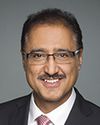Good morning, everyone. Thank you so much for inviting me to speak with you.
I have been asked to appear today to speak about the Canada infrastructure bank and the smart cities challenge. This is my second visit to the committee. I'm so honoured to be here.
I also want to talk about what my department is doing to deliver on our government's commitment to invest in Canadian communities.
I'm joined by my DM, Mr. Tremblay; Jeff Moore, ADM for policy and communications; and my parliamentary secretary, Marc Miller, who recently joined the team. Also with me is Glenn Campbell, the executive director for the Canada infrastructure bank transition office.
As you know, in budget 2016 we launched the first phase of our infrastructure plan, and we wasted no time in rolling it out. We signed bilateral agreements with all the provinces and territories and approved over 1,000 projects under the new plan. Based on the information provided to us by our provincial and municipal partners, 60% of those projects are already under way.
That is just the first step. On November 1, the Government of Canada laid out the fiscal framework for our long-term infrastructure plan through the fall economic statement. The plan will invest more than $180 billion in federal funding, doubling over the next 12 years. These investments will create long-term economic growth; build inclusive, sustainable communities; and support a low-carbon, green economy.
Our plan is focused on five key areas: public transit, green infrastructure, social infrastructure, trade and transportation, and rural and northern communities.
To maximize the benefits of our infrastructure investments, our government is committed to finding new and innovative ways to fund infrastructure and mobilize private capital. As part of our fall economic statement, we announced the creation of the Canada infrastructure bank.
Canada has a very mature market when it comes to infrastructure projects and partnerships with the public and private sectors. Many key pieces of infrastructure, like Edmonton's light rail transit system and the Iqaluit international airport improvement project, were financed in part by the private sector.
We believe there is an opportunity for the federal government to crowd in private sector investment in infrastructure through loans, loan guarantees, and equity participation. The bank will do just that and create more options and opportunities for provinces, territories, and municipalities across the country to undertake large, transformative infrastructure projects.
The bank will invest $35 billion in new projects across Canada, projects like major public transit systems in larger cities, energy transmission corridors, bridges and ports, and more. Of the $35 billion planned to capitalize the bank, $15 billion will be sourced from the announced funding for public transit, green infrastructure, and trade and transportation infrastructure. This $15 billion is less than 8% of the total infrastructure funds announced in the fall economic statement. An additional $20 billion in capital will be available to the Canada infrastructure bank for investments, which will result in the bank holding assets in the form of equity or debt. This $20 billion will therefore not result in a fiscal impact for the government.
The bank will serve as a single federal government point of contact for the private sector and will employ private sector experts to enable the government to invest efficiently with private capital. The bank’s funds are over and above the commitment we made to doubling infrastructure funding. More importantly, it offers our funding partners a new way to help meet their pressing infrastructure needs.
By using private capital to build these new projects, public money will be freed to build more public infrastructure. The bank will be a centre of excellence in infrastructure investment by the private sector, providing advice to allow for better planning and procurement decisions.
To be clear, many infrastructure projects will have no need for the bank and we will not impose it on any of our partners, but we will work with willing partners who think this can offer them additional value. The vast majority of the infrastructure funding will still be delivered through the traditional financial contributions to municipalities, through our bilateral agreements or national programs, but the bank is another tool that our partners can use to invest in the infrastructure they need.
As I said, the use of the Canada infrastructure bank is entirely at the discretion of communities. We hope to see engagement and participation from cities from across Canada through the smart cities challenge, which we also announced in the fall economic statement. The challenge is modelled on similar competitions around the world and aims to accelerate the planning and adoption of innovative infrastructure. It will be an opportunity for our communities to innovate, take risks, and think outside the box.
We will invite Canadian communities to develop integrated, innovative, evidence-based solutions to improve the quality of life for residents, ultimately supporting long-term transformative change across Canada. We have seen smart cities challenges launched by countries across the globe, from the U.S. Department of Transportation's smart city challenge to the Nordic Council of Ministers' Nordic built cities challenge.
These smart cities' initiatives illustrate the changing nature of our world and cities, and the opportunity that information technology and innovation can afford us moving forward. Canadian cities face the same mobility, environmental, and social challenges and we must respond with innovative ideas.
As laid out in the fall economic statement, we will be launching this challenge this year but we strongly believe that our cities must be at their absolute best to compete globally, and initiatives like the smart cities challenge will help drive innovation and foster positive change in our communities. Canada's cities are growing at such a rapid rate when it comes to infrastructure investment that the status quo is no longer acceptable. Now is the time to make smart infrastructure investments that will prepare communities for the challenges ahead and allow them to prosper for generations to come.
Our government is making more infrastructure investment than ever before, but more importantly, we are making strategic, targeted, and transformative investments. We are investing in Canadians and in Canada's future.
Thank you so much for having me here.



